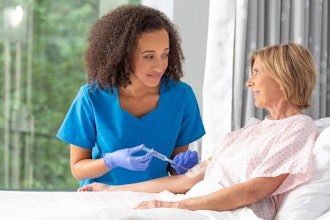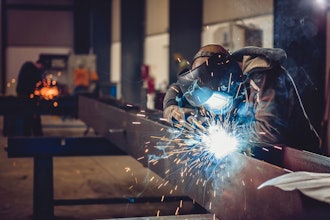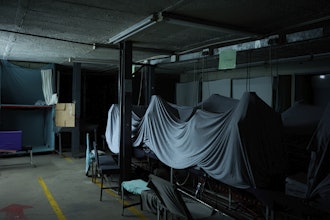Inside its cold-storage warehouse, one U.S. food processing facility had a serious problem. Because of constant traffic in and out, warm air routinely seeped into the space; inevitably it contacted cold steel ceiling joists, causing water to bead up and drip on people and product below. To stop the “rain,” employees draped tarps across the ceiling below the joists and drained the tarps every few weeks. Finding a permanent solution was made more challenging by the fact that they didn’t want to broadcast their problem.
Companies in the food business are rarely eager to discuss problems, even after they’ve solved them. But condensation can affect virtually any food-handling facility at one time or another, so it can be useful to describe solutions even when the facility itself chooses to remain anonymous.
In this example, the company ultimately discovered that installing several high-volume, low-speed (HVLS) ceiling fans designed for harsh environments alleviated the condensation issue enough that they were able to remove the tarps.
The Condensation Challenge
Most people are familiar with condensation, whether on the outside of a cold beverage on a warm day or the inside of eyeglasses when sipping a hot drink. Condensation forms because cold air cannot hold as much moisture as warm air. When warmer, more moisture-laden air contacts a cold surface and becomes colder, it reaches a point of saturation — the dew point. Below its dew point, air’s ability to hold moisture is reduced, and it deposits excess moisture on the cold surface. In commercial facilities, that is most often glass, metal or concrete, and that’s when the problems begin, from worker safety and productivity issues to product contamination, recalls and worse.
As a liquid, condensation forms on floors, threatening people’s safety. And like the example above, condensation also forms on ceilings, fixtures and pipes, where it can drip onto machinery, packaging and product, potentially depositing bacteria along with it. In cold-storage facilities condensation can turn into frost, which shortens equipment life, and ice buildup, which is both a regulatory concern and a sign of energy waste.
The most cost-effective way to mitigate condensation is a question that continues to challenge facility managers and engineers. One approach that has proven successful in many applications is the widespread and constant air movement created by large-diameter HVLS fans.
Bringing A Breeze To The Freezer
One food processor that has discussed its condensation problems is McCain Foods (Canada) in Carberry, Manitoba.
Manitoba province is a major producer of potatoes, and McCain Foods is a major player there. Each year, about 430 million pounds of spuds enter its facility in Carberry. Most will be turned into frozen french fries, and many of those will end up in McDonald’s Happy Meals. But McCain’s had a problem with condensation that was complicating the process and getting inspectors’ attention.
Like many food-handling facilities, the Carberry plant was originally built for another purpose: to train pilots during World War II. Years later it was transformed into a frozen-foods plant and outfitted with a 12,000-sq-ft freezer zone where packaging is done. But creating an airtight freezer zone is always difficult, and that’s especially true in older buildings. Different environmental conditions in neighboring parts of the facility penetrated the freezer, leading to significant ice buildup on the ceiling and walls.
To avoid contaminating open containers of french fries, workers would routinely scrape the ceilings to keep the ice buildup under two inches. McCain tried using small high-velocity fans to circulate air and reduce buildup, but they only affected a small area.
Then the company learned of HVLS fans, and installed one that measured 24-ft across. After two weeks on the job, the ceiling was “completely clear,” said Geoffrey Aitchison, the chief engineer at the time. The air circulation helps keep the ceiling the same temperature as the air, “so the frost isn’t going to stay there,” he added.
Now, almost 10 years after they were installed, the fans are still performing the job they were installed to do, said current McCain HVAC engineer Mike Posthumus.
After witnessing the benefits of using HVLS fans in the freezer, McCain Foods decided to address another problem area. They installed a second 24-ft fan in the processing section, where condensation was forming on the ceiling above a tank and growing mold. “We put the second fan in for energy conservation. We wanted to keep the warm air at the top of the ceiling circulating so we wouldn’t have to run the air makeup units as hard,” said Aitchison. “After running up there for two weeks... there’s no mold growing,” he added.
By circulating air into every corner, HVLS fans help evaporate surface moisture, which reduces the likelihood of mold. It’s one of numerous benefits that facilities experience after installing the fans.
HVLS Fans’ Other Benefits
Unlike small, high-velocity fans that create turbulent air streams that dissipate quickly, large-diameter HVLS overhead fans use a very small motor and aerodynamic airfoils to efficiently move massive amounts of air over large areas. The fans produce a column-shaped jet roughly equal to the fan’s diameter, which heads to the floor and then spreads out in every direction, setting up a circulation pattern through the space. Air at floor level is pushed toward walls or obstructions and then spreads back up and across the ceiling to be recirculated. This thorough and continuous pattern of air movement provides a host of benefits.
As more food manufacturers are learning each year, HVLS fans keep temperatures uniform from wall to wall and floor to ceiling. This increases product uniformity and means product can go out the door more quickly. And now there are stainless-steel washdown HVLS fans specifically designed with food manufacturers in mind.
Though large and powerful, HVLS fans are renowned for their energy efficiency. By creating a uniform temperature and humidity, they reduce HVAC demand and can save companies up to 30% on heating costs. And by speeding up the evaporation process, they can prolong equipment life.
Of course, HVLS fans’ benefits to food processing facilities extend beyond product safety to employee safety. Condensation on concrete floors is a problem not just in food production but anywhere that temperatures collide, whether from doors that constantly open and close, inadequate insulation, water-reliant processes or changing weather conditions. By reducing condensation, the risk of employee accidents due to slippery floors is dramatically reduced. There is even a system now available that can monitor temperature and humidity in order to predict a condensation event and work in tandem with fans to prevent it from becoming a problem.
It’s important to keep in mind that the first priority in fighting condensation should always be a well-designed, properly sealed building with good insulation and ventilation. And in food manufacturing facilities, no mitigation approach can ever claim to be a one-size-fits-all solution — that goes for HVLS fans, too. But HVLS fans’ powerful air movement has helped many food facilities make significant inroads against condensation at relatively little cost. As part of an overall approach to reducing condensation and creating a safer, healthier and more efficient environment, HVLS fans have proven themselves time and time again.
Jamison Stoike is a writer at Big Ass Fans, a Kentucky-based manufacturer of HVLS fans with more than 60 engineers on staff.























